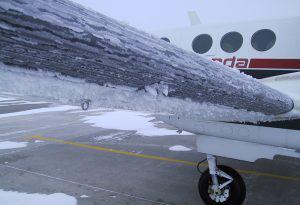Survive Flying In DANGEROUS Icing Conditions | The PREREQUISITE Survival Guide
You Don’t Want to do This!
(For Simulator Pilots only – Real World please please see your QFI)

Flying in Icing conditions is something we should never do and even if your aircraft has de icing equipment its still not a great idea. Remember anything mechanical can fail and it normally happens at the most inopportune time.
Flight simulators like X Plane 11, Microsoft Flight Simulator 2020 and Prepar3d by Lockheed Martin can all give you icing experience. It is an interesting phenomenon to experience in a sim and I never want to experience in a light aircraft.
Flying in Icing Conditions – What causes it? Airliners are Not Immune to Icing!

Flying in icing conditions is not hard to do accidentally if your unfamiliar with the conditions you need to get ice on your aircraft. Icing not unusually requires moisture in the form of cloud, rain to a point or high humidity which can be near clouds as well. The next important factor is temperature. Ice occurs when the temperature is at freezing being zero degrees Celsius.
Its important to know that that from zero to usually minus 10 degrees you can get icing but on occasion down to -20 is also possible. If conditions are just right or really just wrong then even at 2 degrees C you can get Icing occurring. Once of the most dangerous areas is being in zero degrees air in cumulus clouds between stratus cloud. This is a dangerous place to be in a light aircraft for sure.
- Joystick / HOTAS – AMAZON.com
- Rudder Pedals – AMAZON.com
- Throttle Quadrant – AMAZON.com
- Gaming Chair – AMAZON.com
- VR Headset – AMAZON.com
Types of Icing Aviation .
There are a number of different types of icing encountered in aviation. This is relevant to what the icing is effecting on the aircraft:
Structural Icing.
Structural Icing is the Ice that forms on the aircraft structure like the wings, windscreen and control surfaces. This icing does have a number of forms but the danger here can be that it builds up to stop surfaces operating correctly and the second and probably more dangerous effect if that’s possible is disrupting the airflow on the wings and causing the wing to stall.

Induction System Icing.
Induction System Icing is where the cold air and moisture from the outside air start to form on the carburetor throat or throttle body. This restricts the airflow and the performance is reduced until the engine cannot operate and the engine stops. Not a good result. This can happen in conditions you may not consider the icing may occur on the aircraft itself as the venturi effect cools the air even more when entering the system.
This is noticed by pilots when the engine loses performance and noticeably RPM. It sometimes shows itself in momentary loss of power. Engaging the carb heat which ducts warm air from around the exhaust system into the inducting system will normally clear this. Just don’t wait to long to react or the game could be over fast.
Instrument System Icing.
Instrument Icing is also a serious danger to all aircraft including airliners. There have been a number of crashes where ice has been part of the cause. It is common for instruments that require vacuum or static air from outside to make a reading to fail once blocked.
In airliners the pilots instruments often seem to come from the static ports on the 1st officers side so it one side fails there is a difference in reading and one altimeter may say climbing and the other falling at the same time.


At night or in cloud the issue is very much exacerbated. Its a dangerous condition so knowing your in possible icing conditions should bring your alarm bells to warning level!
What Ice Effects – Airframe.
Icing effects on aircraft specifically airframe cause both a build up in weight which can cause issues with the balance and controllability of the aircraft. Ice can build up enough to restrict vision through the widescreen making it very difficult to fly and land if not removed.
Ice also causes a loss of aerodynamic lift by disturbing the boundary layer over flying surfaces causing the air to break away from the wing and we loose aerodynamic lift. No lift and we don’t fly anymore.
What Ice Effects – Instruments.
Instruments rely on static air and well as vacuum and pitot tubes for atmospheric information. These can easily be blocked by ice on the airframe and impacts our ability to fly in IFR conditions.
The time you need not to be alone is when your in trouble and there is no one to talk to because your radio has unexpectedly stopped working. Ice on aerials also causes issues with radios and you could be at altitude in cloud with Ice forming and no one to help you.

Levels Of Icing – Icing Intensity Classification.
When flying in icing conditions you can make pilot reports to ATC or general broadcast for other pilots in the area. You can specify the level of icing you have encountered while flying in a number of recognized levels:
1: Trace – Perceptible but no accumulation on the aircraft
2: Light – A significant amount of Ice encountered over a longer period EG: 1 hour
3: Moderate – A significant amount accumulated for shorter periods of flight
4: Severe – This is a rapid dangerous accumulation of ice.
Levels Of Icing – Icing Intensity Effects.

The Icing intensity effects is directly describing the effect the ice accumulation has on the aircraft. How it effects systems and aircraft performance. This is broken down into 4 classifications:
1: TRACE – This describes no effect with or without deicing equipment.
2: LIGHT – Occasional use of de-icing equipment removes the ice without it building up.
3: Moderate – This describes a more severe buildup of ice requiring frequent de icing equipment use and possible diversion of the flight due to hazardous conditions.
4: Severe: Immediate diversion required as deicing equipment cannot prevent the dangerous buildup of ice on the aircraft.

Flying In Icing Conditions – Cloud Types and Dangers.
Cumulus Cloud Icing Dangers.
Cumulus cloud icing dangers are more narrow than other clouds but extend higher. The chance is the icing even will be relatively short and occurs towards the top of a fully formed cumulus cloud. Temps of 0 to -20 are likely to be experienced
Stratus Cloud Icing Dangers.
Stratus clouds are more dangerous as they tend to carry more water and are more spread out so the event will be longer if you remain. The temps are normally 0 to -10 degrees in this cloud. It is normally less severe icing than in a cumulus cloud but again it will last much longer due to the width of the cloud.
Freezing Rain – Icing Dangers.


Icing can occur ahead of warm air fronts when rain is present and the aircraft is above a cold air mass. This is a serious Icing danger as the water droplets are also often larger and the icing is more severe. There is a very high catch or accumulation rate in these conditions.
Freezing Drizzle – Icing Dangers.
Freezing drizzle is a very serious event. This occurs under stratus clouds and the subsequent rain and ice builds quickly. In the event of flying into drizzle below a stratus cloud a decision needs to be made quickly as it can take only 6 minutes for the condition to become extremely hazardous.
Real World Example Take Note!
This is a great example of what can happen when flying in icing conditions. Listen to this real world story and take some good notes.
Flying In Icing Conditions – Strategies to stay Safe!
Check the weather reports and if the temperatures are between Plus 2 degrees Celsius to minus 20 degrees Celsius and their is moisture in the form of clouds, mist or rain then you should evaluate your need to fly.
Flight Planning to stay away from potential icing conditions where cloud or rain exist with very low temperatures around 0 to -0. General Aviation aircraft rely on both leading edge rubber boots that expand to crack the ice and remove it as well as fluid dispensing to remove ice. These systems are not fool proof and ice can build up to a point they can no longer cope. Angle of attack generally increases as the pilot tries to keep altitude. The results is after some time the AOA exceeds critical levels and control is lost and the aircraft generally crashes.
In the last 19 years according to Google.com the re have been 583 accidents due to icing with 800 fatalities.
Your job in X Plane 11 and MSFS 2020 or any Sim is to not die due to Icing. Plane because you will encounter icing. My video from some time back when LetsFlyVFR was a new channel actually surprised me how fast it affected the controllability in the sim. It went from a slight extra weight to uncontrollable very fast. The sad thing is X Plane 11 does not seem to animate icing but Microsoft Flight Simulator does apparently. The TBM picture is from MSFS 2020 but I cannot say it has not been paints shopped.
The moral of the story is if its cold wet and windy reconsider your need to fly! In a Simulator you can fly and see if you die! Its ok to reset and start again.
The real world does not have this option. Enjoy your flight simulator whatever your preference and if you want to experience icing set up conditions and see if you survive.
- Latest CPU’s Available Now – Amazon.com
- Get a NEW GPU Best Performance – AMAZON.com
- Upgrade RAM Here today – AMAZON.com
- Prebuilt PC Options – AMAZON.com
Author.

Brendon McAliece is a multi lingual-expat who brings over three decades of flight simulator/PC building experience as well as over two decades of real world jet fighter experience as a weapons/egress technician. He holds a sport pilot certificate giving him real world flying experience. Hi travels have taken him from Europe to the Middle East, Asia and his home of Australia. He has a passion for travel, languages, flight simulation as well as guitaring and coffee. You can read more in his blogs below.
Learn More @ DreamingGuitar.com – DreamingCoffee.com – LetsFlyVFR.com
( HOME – BLOG – SHOP – ABOUT )
As an Amazon affiliate I may benefit from qualifying sales.









